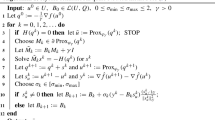Abstract
We consider a control problem for a nonlinear diffusion equation with boundary input that occurs when heating ceramic products in a kiln. We interpret this control problem as a constrained optimization problem, and we develop a reduced SQP method that presents for this problem a new and efficient approach of its numerical solution. As opposed to Newton's method for the unconstrained problem, where at each iteration the state must be computed from a set of nonlinear equations,in the proposed algorithm only the linearized state equations need to be solved. Furthermore, by use of a secant update formula, the calculation of exact second derivatives is avoided. In this way the algorithm achieves a substantial decrease in the total cost compared to the implementation of Newton's method in [2]. Our method is practicable with regard to storage requirements, and by choosing an appropriate representation for the null space of the Jacobian of the constraints we are able to exploit the sparsity pattern of the Jacobian in the course of the iteration. We conclude with a presentation of numerical examples that demonstrate the fast two-step superlinear convergence behavior of the method.
Similar content being viewed by others
References
J. Burger and C. Machbub, “Comparison of numerical solutions of a one-dimensional nonlinear heat equation” Commun. Appl. Numer. Methods, 7, pp. 1–14, 1991.
J. Burger and M. Pogu, “Functional and numerical solution of a control problem originating from heat transfer,” J. Optim. Theory Appl., 68, pp. 49–73, 1991.
R.H. Byrd, “An example of irregular convergence in some constrained optimization methods that use the projected Hessian,” Math. Programming, 32, pp. 232–237, 1985.
R.H. Byrd, “On the convergence of constrained optimization methods with accurate Hessian information on a subspace,” SIAM J. Numer. Anal. 27, pp. 141–153, 1990.
R.H. Byrd and J. Nocedal, “An analysis of reduced Hessian methods for constrained optimization,” Math. Programming, 49, pp. 285–323, 1991.
T.F. Coleman and A. R. Conn, “On the local convergence of a quasi-Newton method for the nonlinear programming problem,” SIAM J. Numer. Anal.,21, pp. 755–769, 1984.
J.E. Dennis and R.B. Schnabel, Numerical Methods for Unconstrained Optimization and Nonlinear Equations, Prentice-Hall: Englewood Cliffs, NJ, 1983.
D. Gabay, “Reduced quasi-Newton methods with feasibility improvement for nonlinearly constrained optimization,” Math. Programming Study, 16, pp. 18–44, 1982.
J.C. Gilbert, “Une méthode de quasi-Newton réduite en optimisation sous contraintes avec priorité à la restauration,” in Proc. of the Seventh Int. Conf. on Analysis and Optimization of Systems, A. Bensoussan and J.L. Lions, eds., Springer: Heidelberg, Germany, pp. 40–53, 1986.
J.C. Gilbert, “On the local and global convergence of a reduced quasi-Newton method”, Optimization, 20, pp. 421–450, 1989.
C. B. Gurwitz, Local convergence of a two-piece update of a projected Hessian matrix, Department of Computer and Information Science, Brooklyn College, Brooklyn, NY, tech. report, 1991.
D.H. Jacobson and D.Q. Mayne, Differential Dynamic Programming, Elsevier, New York, 1970.
K.Kunisch and E. W. Sachs, “Reduced SQP methods for parameter identification problems,” SIAM J. Numer. Anal., to appear.
F.-S. Kupfer, An infinite-dimensional convergence theory for reduced SQP methods in Hilbert space, Universität Trier, Fachbereich IV — Mathematick, tech. rep., 1990.
F.-S. Kupfer, Reduced successive quadratic programming in Hilbert space with applications to optimal control, doctoral thesis, Universität Trier, 1992.
F.-S. Kupfer and E.W. Sachs,“A prospective look at SQP methods for semilinear parabolic control problems,” in Optimal Control of Partial Differential Equations, Irsee 1990, K.-H. Hoffmann and W. Krabs, eds., vol. 149, Springer Lect. Notes in Control and Information Sciences, 1991, pp. 143–157.
J. Nocedal and M.L. Overton, “Projected Hessian updating algorithms for nonlinearly constrained optimization,” SIAM J. Numer. Anal., 22, pp. 821–850, 1985.
Y. Yuan, “An only 2-step q-superlinear convergence example for some algorithms that use reduced Hessian approximations,” Math. Programming, 32, pp. 224–231, 1985.
J. Zhang and D. Zhu, “A trust region type dogleg method for nonlinear optimization,” Optimization, 21, pp. 543–557, 1990.
Author information
Authors and Affiliations
Rights and permissions
About this article
Cite this article
Kupfer, F.S., Sachs, E.W. Numerical solution of a nonlinear parabolic control problem by a reduced SQP method. Comput Optim Applic 1, 113–135 (1992). https://doi.org/10.1007/BF00247656
Received:
Revised:
Issue Date:
DOI: https://doi.org/10.1007/BF00247656




